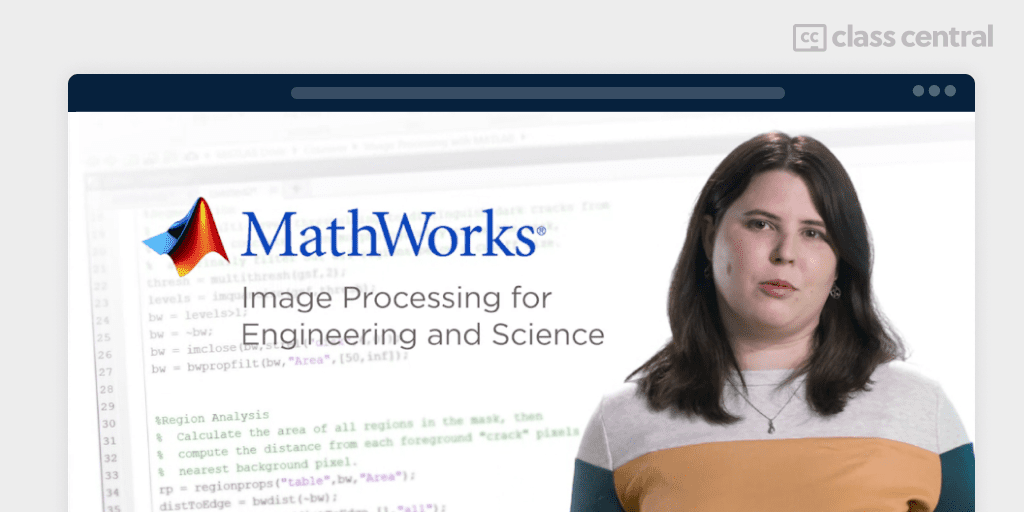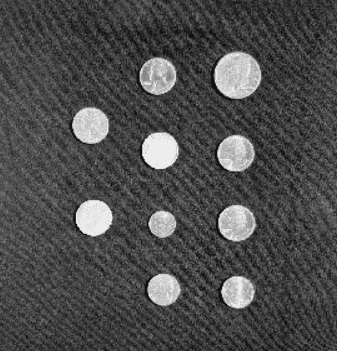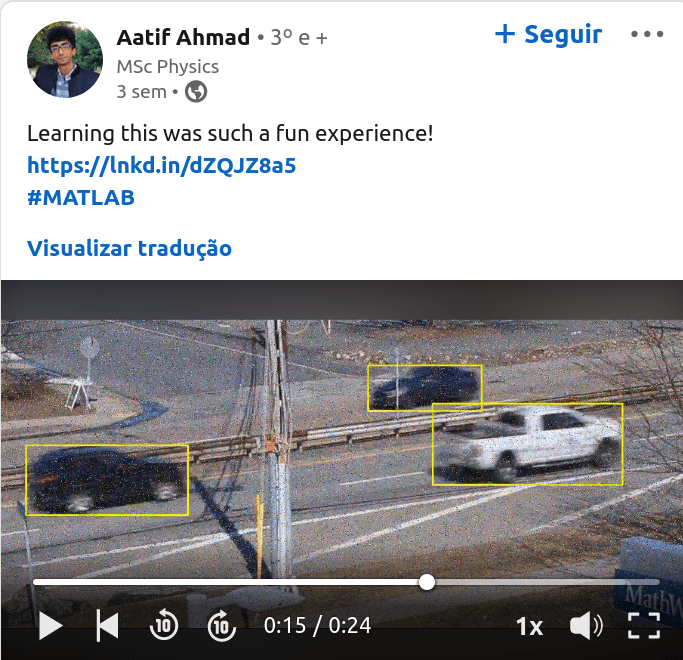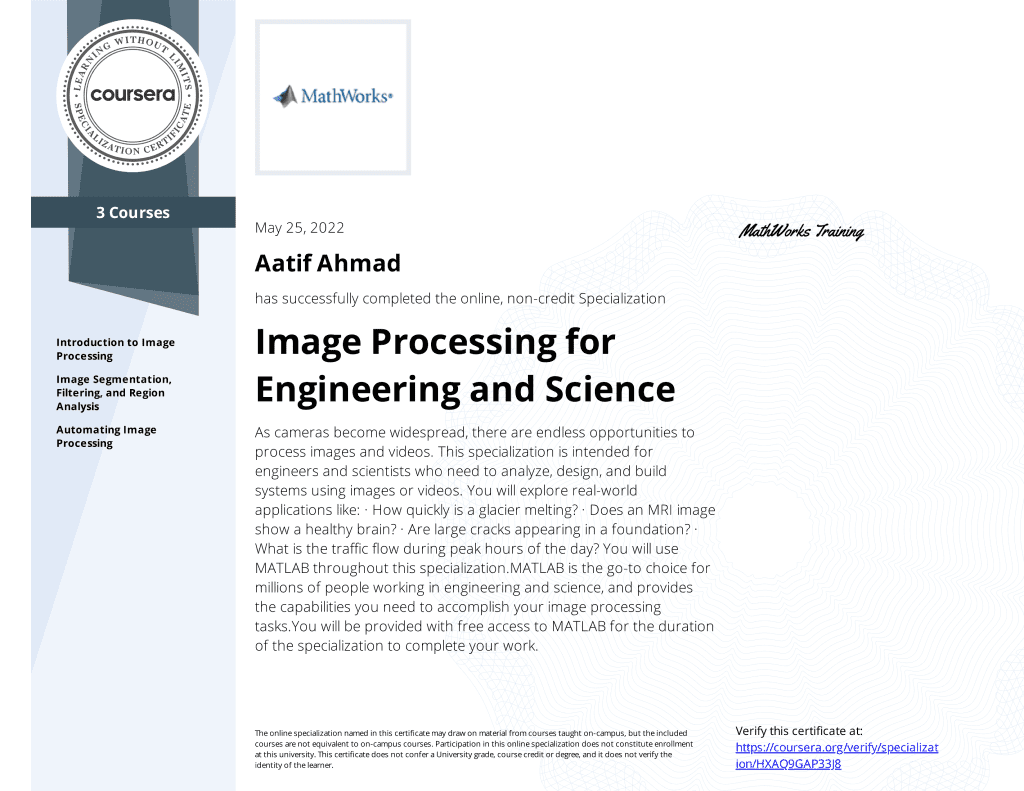Specialization review: Image Processing for Engineering and Science by Mathworks
Learn how to use MATLAB for image processing, segmentation, and video processing. Develop a project to detect moving vehicles to analyze traffic patterns.

Have you ever wondered how Astro-physicists are able to study the universe through pictures? How Doctors are able to accurately diagnose medical conditions? How Climatologists are able to study the effects of climate change? Or maybe how the Engineers are able to make self-driving cars? Image processing is a huge part of all these applications, and more!
If you answered “yes” to any of the above, or if you’d like to understand what, and how images and videos work, then I’d gladly recommend the Image Processing for Engineering and Science specialization by MathWorks offered on Coursera. This Specialization consists of three courses: Introduction to Image Processing, Image Segmentation, Filtering, and Region Analysis, & Automating Image Processing which takes the learner from basic to advanced through the duration of the course.
Here’s an overview of what the course covers from the various instructors for the courses:
Why I took this specialization
I’m a student of Physics, and I’ll be starting my post-graduation (Master’s degree) in a few months. I have worked on MATLAB before during my under-graduation (Bachelor’s degree) but Image Processing was extremely new for me, so when I came across this specialization offered by MathWorks itself, I jumped at the opportunity to learn. While my biggest reason to take this course was curiosity, I certainly hope I’d use my newly acquired skills in my future research work!
Prerequisites
While the specialization does start from the very basics of Image Processing, you should be fairly familiar with MATLAB itself. You won’t need to be extremely good at it, just a basic knowledge is enough. For this I’d highly recommend the free MATLAB Onramp course offered by MathWorks on their website.
While technically there isn’t any other prerequisite, something that really helped me grasp the concepts and do the projects throughout the course was my understanding of a few coding languages. I’ve studied C++ and JAVA before, and the understanding of data structures, functions, loops and conditional statements were extremely beneficial in completely grasping the depth of what the instructors were teaching, and applying those myself in the given projects.
The Specialization
The Specialization is divided into three courses, multiple quizzes and projects which are graded by an online grader tool, and at the end of the specialization you’re required to do a project in which you’ll be applying all of the concepts you’ve learnt so far throughout the three courses. For most of the quizzes you’re required to score equal to or more than 80%. However, in the final project you’re required to get 100%.
The first course of the specialization, Introduction to Image Processing introduces you to working with digital images. You’ll be able to understand how images are represented, learn about different color spaces, how you can convert between them, or how you can just view a particular color’s intensity in the whole image. You’ll also learn how to segment images to extract the important regions in an image, and how you can manipulate them by changing their contrast, brightness, increasing the visibility of underexposed images, and even reducing the haze/fog present in an image.
By the end of this course you’ll be able to segment a picture of the Melted ice on George VI Ice Shelf, Antarctica, and calculate how much the ice melted in two years, from 2018 to 2020.

The second course of the specialization, Image Segmentation, Filtering, and Region Analysis deals with the common challenges you might find while segmenting images, like reducing noise, isolating overlapping images, detecting edges in an image, segmenting based on various region properties, to make sure that you’re segmenting only the required parts of the image. You’ll also be introduced to 3D images (Volumes), and how you can segment 3 dimensional images!
By the end of this course, your code will be able to distinguish between a real and a fake coin in a picture.

The third and final course of the specialization, Automating Image Processing helps you apply everything that you’ve learnt so far to hundreds, or even thousands of images at once. And it introduces you to video processing, which are essentially multiple different frames of images in sequence. So, by the end of this course you’ll be applying everything you know to videos!
The Final Project requires you to detect moving vehicles in a noisy video to analyze traffic patterns, and create your own video with a bounding box surrounding every vehicle. You can see my final project here.

After you complete each course you’ll be provided with individual course certificates, and once you complete all three you’ll receive a separate certificate for the specialization.
Materials and Difficulty level
On top of the video lectures, the extra reading materials that were provided really helped in understanding things much more clearly. The content is very easy to follow and is written in simple, easy to understand language. The instructors did a phenomenal job at explaining complicated things in such a simple way.
Depending on your level of comfort with coding, the difficulty may vary. Although the video lectures are 5 to 10 minutes at max, you might want to pause and code things yourself to really understand what’s going on. From my experience it took me anywhere from 30 minutes to an hour or so just for a 5-10 minute video to really feel comfortable and move on to the next section, so don’t be afraid of moving slowly, in fact, I’d highly suggest going slowly, especially if you’re new to this. And make sure to use the MATLAB documentation as you come across new keywords or functions.
Conclusion and key takeaways

As I progressed through this course I found myself getting more and more confident as everything in the course was connected to each other, my fundamentals got stronger with each finished module. Now, I’m excited and confident that I’ll be able to apply image processing in my research work.
I’d highly recommend this specialization to anyone in the Science & Engineering field, be it students, or working professionals.
Finally I’d like to give a huge thank you to the MathWorks team who made these courses possible, they did a great job with it and I’m looking forward to more such courses related to my fields of interest.






